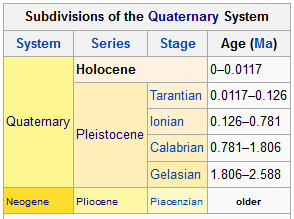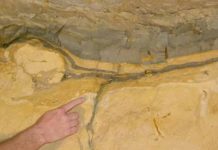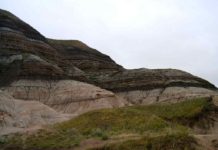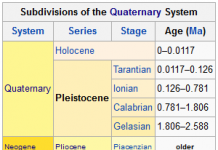The Holocene is a geological epoch which began at the end of the Pleistocene (at 11,700 calendar years BP) and continues to the present. The Holocene is part of the Quaternary period. Its name comes from the Greek words ὅλος (holos, whole or entire) and καινός (kainos, new), meaning “entirely recent”. It has been identified with the current warm period, known as MIS 1 and based on that past evidence, can be considered an interglacial in the current ice age.
The Holocene also encompasses within it the growth and impacts of the human species world-wide, including all its written history and overall significant transition toward urban living in the present. Human impacts of the modern era on the Earth and its ecosystems may be considered of global significance for future evolution of living species, including approximately synchronous lithospheric evidence, or more recently atmospheric evidence of human impacts. Given these, a new term Anthropocene, is specifically proposed and used informally only for the very latest part of modern history and of significant human impact since the epoch of the Neolithic Revolution (around 12,000 years BP).
Overview
It is accepted by the International Commission on Stratigraphy that the Holocene started approximately 11,700 years BP (before present). The period follows the last glacial period (regionally known as the Wisconsinan Glacial Period, the Baltic-Scandinavian Ice Age, or the Weichsel glacial). The Holocene can be subdivided into five time intervals, or chronozones, based on climatic fluctuations:
- Preboreal (10 ka – 9 ka),
- Boreal (9 ka – 8 ka),
- Atlantic (8 ka – 5 ka),
- Subboreal (5 ka – 2.5 ka) and
- Subatlantic (2.5 ka – present).
Note: “ka” means “thousand years” (non-calibrated C14 dates)
The Blytt-Sernander classification of climatic periods defined, initially, by plant remains in peat mosses, is now being explored currently by geologists working in different regions studying sea levels, peat bogs and ice core samples by a variety of methods, with a view toward further verifying and refining the Blytt-Sernander sequence. They find a general correspondence across Eurasia and North America, though the method was once thought to be of no interest. The scheme was defined for Northern Europe, but the climate changes were claimed to occur more widely. The periods of the scheme include a few of the final pre-Holocene oscillations of the last glacial period and then classify climates of more recent prehistory.
Paleontologists have defined no faunal stages for the Holocene. If subdivision is necessary, periods of human technological development, such as the Mesolithic, Neolithic, and Bronze Age, are usually used. However, the time periods referenced by these terms vary with the emergence of those technologies in different parts of the world.
Climatically, the Holocene may be divided evenly into the Hypsithermal and Neoglacial periods; the boundary coincides with the start of the Bronze Age in European civilization. According to some scholars, a third division, the Anthropocene, began in the 18th century.
Geology
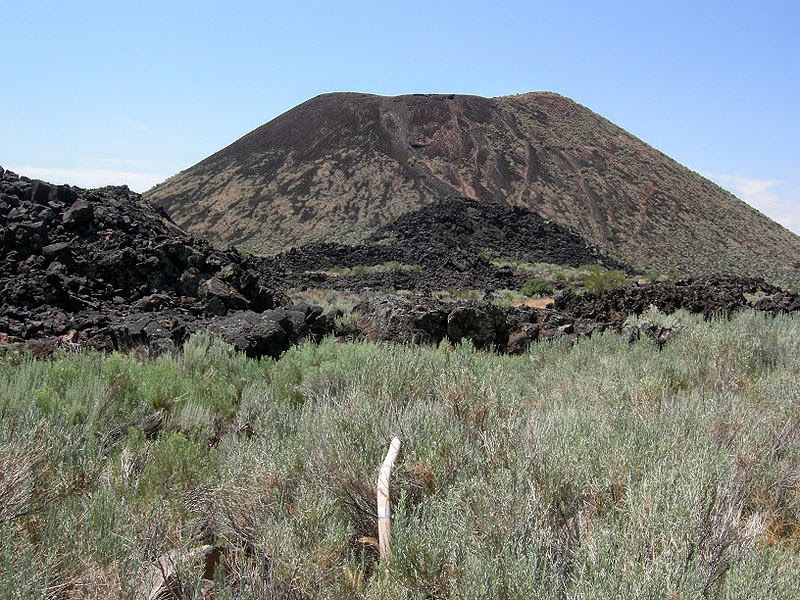
Continental motions due to plate tectonics are less than a kilometre over a span of only 10,000 years. However, ice melt caused world sea levels to rise about 35 m (115 ft) in the early part of the Holocene. In addition, many areas above about 40 degrees north latitude had been depressed by the weight of the Pleistocene glaciers and rose as much as 180 m (590 ft) due to post-glacial rebound over the late Pleistocene and Holocene, and are still rising today.
The sea level rise and temporary land depression allowed temporary marine incursions into areas that are now far from the sea. Holocene marine fossils are known from Vermont, Quebec, Ontario, Maine, New Hampshire, and Michigan. Other than higher-latitude temporary marine incursions associated with glacial depression, Holocene fossils are found primarily in lakebed, floodplain, and cave deposits. Holocene marine deposits along low-latitude coastlines are rare because the rise in sea levels during the period exceeds any likely tectonic uplift of non-glacial origin.
Post-glacial rebound in the Scandinavia region resulted in the formation of the Baltic Sea. The region continues to rise, still causing weak earthquakes across Northern Europe. The equivalent event in North America was the rebound of Hudson Bay, as it shrank from its larger, immediate post-glacial Tyrrell Sea phase, to near its present boundaries.
Climate
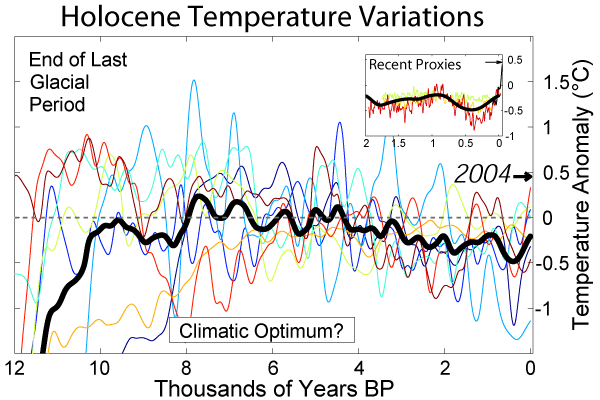
Climate has been fairly stable over the Holocene. Ice core records show that before the Holocene there was global warming after the end of the last ice age and cooling periods, but climate changes became more regional at the start of the Younger Dryas. During the transition from last glacial to holocene, the Huelmo/Mascardi Cold Reversal in the Southern Hemisphere began before the Younger Dryas, and the maximum warmth flowed south to north from 11,000 to 7,000 years ago. It appears that this was influenced by the residual glacial ice remaining in the Northern Hemisphere until the later date.
The hypsithermal was a period of warming in which the global climate became warmer. However, the warming was probably not uniform across the world. This period of warmth ended about 5,500 years ago with the descent into the Neoglacial. At that time, the climate was not unlike today’s, but there was a slightly warmer period from the 10th–14th centuries known as the Medieval Warm Period. This was followed by the Little Ice Age, from the 13th or 14th century to the mid 19th century, which was a period of significant cooling, though not everywhere as severe as previous times during neoglaciation.
The Holocene warming is an interglacial period and there is no reason to believe that it represents a permanent end to the current ice age. However, the current global warming may result in the Earth becoming warmer than the Eemian Stage, which peaked at roughly 125,000 years ago and was warmer than the Holocene. This prediction is sometimes referred to as a super-interglacial.
Compared to glacial conditions, habitable zones have expanded northwards, reaching their northernmost point during the hypsithermal. Greater moisture in the polar regions has caused the disappearance of steppe-tundra.
Ecological developments
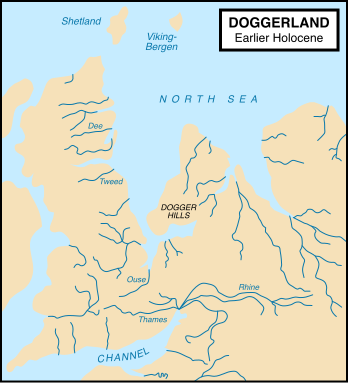
Animal and plant life have not evolved much during the relatively short Holocene, but there have been major shifts in the distributions of plants and animals. A number of large animals including mammoths and mastodons, saber-toothed cats like Smilodon and Homotherium, and giant sloths disappeared in the late Pleistocene and early Holocene—especially in North America, where animals that survived elsewhere (including horses and camels) became extinct. This extinction of American megafauna has been explained as caused by the arrival of the ancestors of Amerindians; though most scientists assert that climatic change also contributed. In addition, a discredited bolide impact over North America which was hypothesized to have triggered the Younger Dryas.
Throughout the world, ecosystems in cooler climates that were previously regional have been isolated in higher altitude ecological “islands”.
The 8.2 ka event, an abrupt cold spell recorded as a negative excursion in the δ18O record lasting 400 years, is the most prominent climatic event occurring in the Holocene epoch, and may have marked a resurgence of ice cover. It is thought that this event was caused by the final drainage of Lake Agassiz, which had been confined by the glaciers, disrupting the thermohaline circulation of the Atlantic.
Human developments
The beginning of the Holocene corresponds with the beginning of the Mesolithic age in most of Europe; but in regions such as the Middle East and Anatolia with a very early neolithisation, Epipaleolithic is preferred in place of Mesolithic. Cultures in this period include: Hamburgian, Federmesser, and the Natufian culture, during which the oldest inhabited places still existing on Earth were first settled, such as Jericho in the Middle East, as well as evolving archeological evidence of proto-religion at locations such as Göbekli Tepe, as long ago as the 9th millennium BC.
Both are followed by the aceramic Neolithic (Pre-Pottery Neolithic A and Pre-Pottery Neolithic B) and the pottery Neolithic. The Late Holocene brought advancements such as the bow and arrow and saw new methods of warfare in North America. Spear throwers and their large points were replaced by the bow and arrow with its small narrow points beginning in Oregon and Washington. Villages built on defensive bluffs indicate increased warfare, leading to food gathering in communal groups rather than individual hunting for protection.
Impact events
Many meteorite events which occurred in the Holocene have so far been found in Europe, in bodies of water such as the Indian Ocean and in Russia, near the remote region of Siberia. Siberia is also the site of a modern impact event in 1908 known as the Tunguska Event. It has been speculated that an impact such as that represented today by the Burckle Crater could have dramatically affected human culture in its early history by the creation of megatsunamis, perhaps inspiring deluge or inundation myths such as that of Noah’s Flood.
Note : The above story is based on materials provided by Wikipedia


